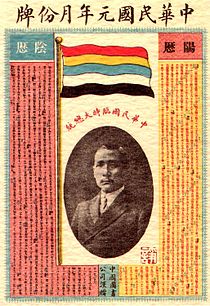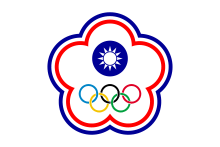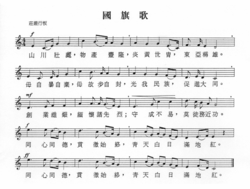- National symbols of the Republic of China
-
This is the current list of the National Symbols of the Republic of China
Official
- National Flag of the Republic of China
The Flag of the Republic of China was adopted in 1928. The flag is also called Blue Sky, White Sun, and a Wholly Red Earth. This was first used when Sun Yat-sen used it as flag of his government-in-exile in Tokyo. After the ROC government was relocated to Taiwan, the ROC flag was no longer in use in the mainland, as the Communists established the People's Republic of China. However, the flag is still displayed in some museums and historical places in the mainland. As the ROC flag has a canton that is the flag of the Kuomintang Party of the Pan-Blue Coalition, supporters of the pro-independence Pan-Green Coalition do not use the ROC flag.
- Flag of Chinese Taipei (flag used by the ROC in the Olympics)
Due to the admission of the PRC in the International Olympic Committee, the ROC was barred to use the ROC National Flag in the Olympics, so the ROC government used a different flag for the Olympics. The Chinese Taipei flag is a white flag with a blue-white-red bordered Plum blossom that has the National Emblem in the upper middle and the Olympic symbol in the lower middle. The ROC (Chinese Taipei in the Olympics) still uses the Chinese Taipei flag.
- National Emblem of the Republic of China
The National Emblem was adopted in 1947. The design is derived from the Blue Sky with a White Sun Flag, which is the flag of the Kuomintang. The emblem is similar to the emblem of the KMT, the only difference being the margin. As this also portrays KMT dominance in the ROC, many people want to change both the flag and the emblem to show a more democratic government.
The National Anthem was adopted in 1937 (de facto), and in 1943 (de jure). The anthem is also known as the San Min-chui (the Three Principles of the People). It was derived from Sun Yat-sen's speech on the inaugural ceremony of the Whampoa Military Academy. It discuuses how the nation can achieve stability through the Three Principles.
The National Flag Anthem was adopted in 1937. The Flag Anthem is also called the National Banner Song. The flag anthem is sung when the National Flag is raised. Because the ROC is barred from using both the ROC flag and anthem in the Olympics, the National Flag Anthem is used in place of the anthem. The National Flag was heard for the first time in the Olympics when the ROC (Chinese Taipei) won a gold medal in the 2004 Summer Olympics.
- National Flower of the Republic of China: Plum blossom
The National Flower was officially designated as the plum blossom by the Executive Yuan of the Republic of China on July 21, 1964.[1] The plum blossom, known as the meihua (Chinese: 梅花; pinyin: méihuā), is symbol for resilience and perseverance in the face of adversity, because plum blossoms often bloom most vibrantly even amidst the harsh winter snow.[2][3] The triple grouping of stamens represents Dr. Sun Yat-sen's Three Principles of the People, while the five petals symbolize the five branches of the government: Executive Yuan, Legislative Yuan, Judicial Yuan, Examination Yuan and Control Yuan.[1][3]
- Father of the Nation: Sun Yat-sen
 Sun Yat-sen, the Father of the Nation.
Sun Yat-sen, the Father of the Nation.
Sun Yat-sen (1866-1925) became the first president of the ROC in 1912, and proposed the Three Principles of the People and the Four-Stage Theory of the Republic of China, which served as the foundation of the Northern Expedition. He is highly honored in both the ROC and the PRC, as in the ROC, presidents take oath in front of Dr. Sun's portrait, and Dr. Sun's portrait is displayed during National Day Celebrations, and in the PRC, his portrait is also displayed during the flag-raising on National Day.
- National Year Designation/Calendar: Minguo Calendar
 A calendar that commemorates the first year of the Republic as well as the election of Sun Yat-sen as the provisional President.
A calendar that commemorates the first year of the Republic as well as the election of Sun Yat-sen as the provisional President.
The year 1911 (the year of the Xinhai Revolution is the beginning of the Mingo calendar. The calendar is patterned with the style wherein once a new government is inaugurated in China, the year goes back to one (1). The year 2011 is Minguo year 100. It is still in current use of the ROC government, but many legislators want to abolish the dating system.
References
- ^ a b Government Information Office, Republic of China - National Flower
- ^ "The Three Friends of Winter: Paintings of Pine, Plum, and Bamboo from the Museum Collection". Taipei: National Palace Museum (國立故宮博物院). http://www.npm.gov.tw/exh91/3friends/english/infor.htm. Retrieved 31 July 2011.
- ^ a b National Flag, Anthem and Flower
National symbols of Asia Sovereign
states- Afghanistan
- Armenia
- Azerbaijan
- Bahrain
- Bangladesh
- Bhutan
- Brunei
- Burma (Myanmar)
- Cambodia
- People's Republic of China
- Cyprus
- East Timor (Timor-Leste)
- Egypt
- Georgia
- India
- Indonesia
- Iran
- Iraq
- Israel
- Japan
- Jordan
- Kazakhstan
- North Korea
- South Korea
- Kuwait
- Kyrgyzstan
- Laos
- Lebanon
- Malaysia
- Maldives
- Mongolia
- Nepal
- Oman
- Pakistan
- Philippines
- Qatar
- Russia
- Saudi Arabia
- Singapore
- Sri Lanka
- Syria
- Tajikistan
- Thailand
- Turkey
- Turkmenistan
- United Arab Emirates
- Uzbekistan
- Vietnam
- Yemen
States with limited
recognition- Abkhazia
- Nagorno-Karabakh
- Northern Cyprus
- Palestine
- Republic of China (Taiwan)
- South Ossetia
Dependencies and
other territories- Christmas Island
- Cocos (Keeling) Islands
- Hong Kong
- Macau
Categories:
Wikimedia Foundation. 2010.






